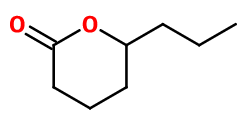
Photo credits: ScenTree SAS
Delta-octalactone
6-propyloxan-2-one ; 5-hydroxyoctanoic acid lactone ; 5-octalactone ; Octano-1,5-lactone ; 5-octanolide ; Octanolactone ; 5-propyl-5-hydroxypentanoic acid lactone ; Delta-propyl-delta-valerolactone ; 6-propyloxan-2-one ; Tetrahydro-6-propyl-2H-pyran-2-one ; 6-propyltetrahydro-2H-pyran-2-one

Photo credits: ScenTree SAS
Do you sell any of the raw materials? Would you like to let our users know?
Send an email to fournisseurs@scentree.coto learn about our advertising opportunities.
Do you sell any of the raw materials? Would you like to let our users know?
Send an email to fournisseurs@scentree.coto learn about our advertising opportunities.
General Presentation
-
CAS N° : 698-76-0
-
EINECS number : 211-820-5
-
FEMA number : 3214
-
Density : 1,001
-
Optical rotation : Donnée indisponible
-
Allergens : This ingredient does not contain any allergen.
-
Refractive Index @20°C : Donnée indisponible
-
Volatility : Base
-
Price Range : €€€
-
Appearance : Colorless liquid
-
FLAVIS number : 10.015
-
JECFA number : 228
Information on synthetic ingredients
-
Acid Value : Donnée indisponible
-
Boiling Point :
-
Detection Threshold : Donnée indisponible.
-
Molecular formula : C8H14O2
-
Log P : 1,16
-
Molecular Weight : 142,2 g/mol
-
Fusion Point : Donnée indisponible.
-
Flash Point : 125°C
-
Vapor pressure : Donnée indisponible
Uses
Other comments :
Delta-Octalactone is one of the lactones with the strongest coconut smell. The smell of other lactones often reminisces a smell of peach or coconut. This lactone is far from being the most used in the perfume industry.
Stability :
Lactones tend to polymerize through time, making them more viscous and leading to a phase shift in alcohol.
Uses in perfumery :
Delta-Octalactone is used in lactonic-coconut, exotic and tropical fruity notes to bring a coconut facet. Used in the fruity flavors and gourmand notes of some fragrances.
Year of discovery :
Data not available.
Isomerism :
Delta-Octalactone is a positional isomer of cis-3-Hexenyl acetate. However, the two molecules are structurally and olfactively different. The asymmetric carbon of this lactone does not change the nature of the molecule produced: only a racemic mixture of the two enantiomers is used in perfumery.
Synthesis precursor :
Delta-Octalactone is not a precursor to the synthesis of another compound of olfactory interest.
Natural availability :
Delta-Octalactone is present in the fragrant principle of several fruits such as peach, apricot or pineapple, as well as butter and some other daily products. Nevertheless, there is no production in its natural state.
Synthesis route :
As for any lactone, Delta-Octalactone is synthesized by the condensation of an acid and an alcohol, which cyclize together, in the presence of an alkaline phosphate or sulphate. Here, the concerned alcohol is butanol and the acid is but-3-enoic acid. The synthesis can also be done by an intra-esterification of 5-hydroxyoctanoic acid. Moreover, as for the synthesis of all lactones, biosynthetic pathways are being developed by the producing companies.
Regulations & IFRA
This ingredient is not restricted

